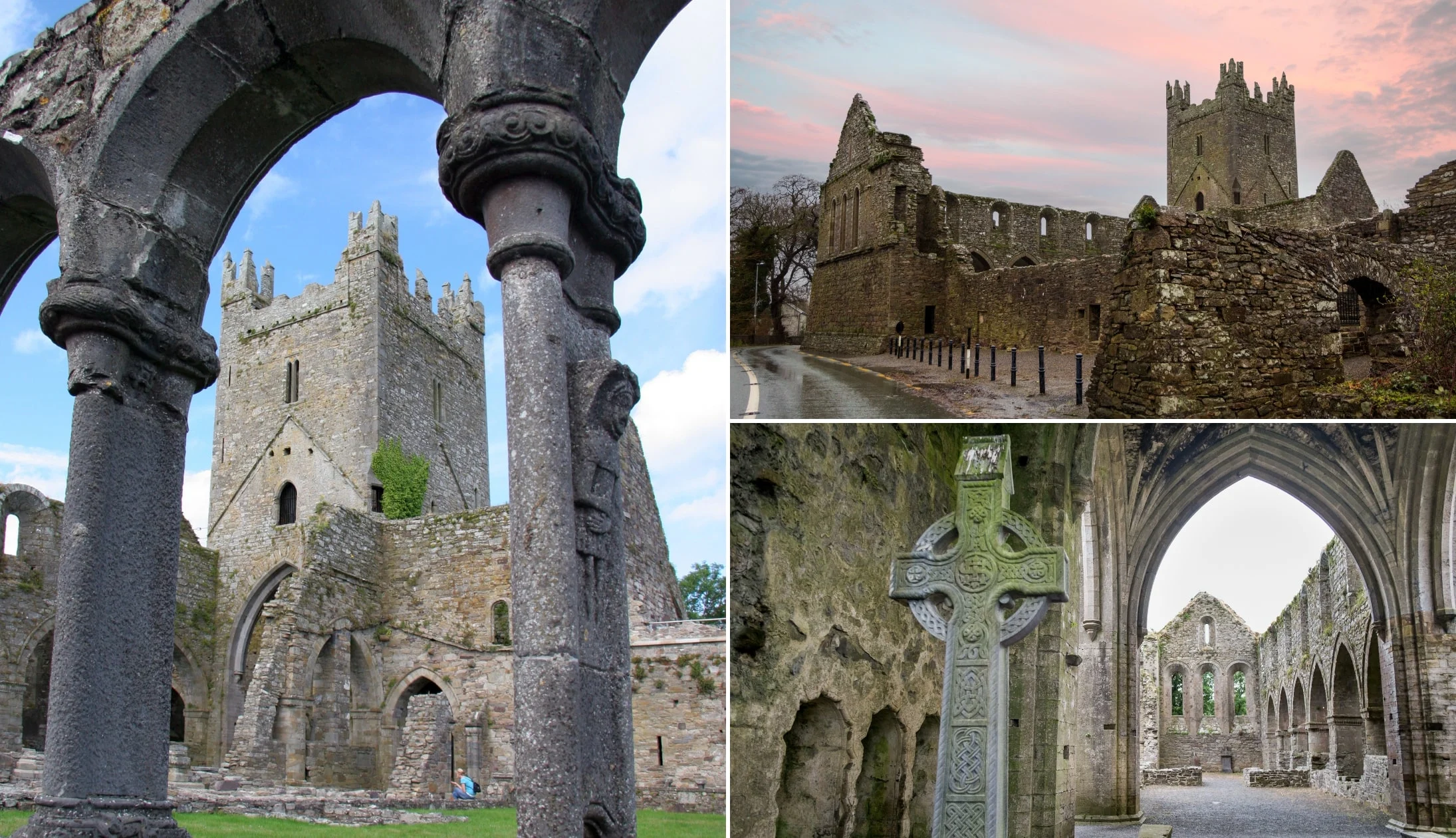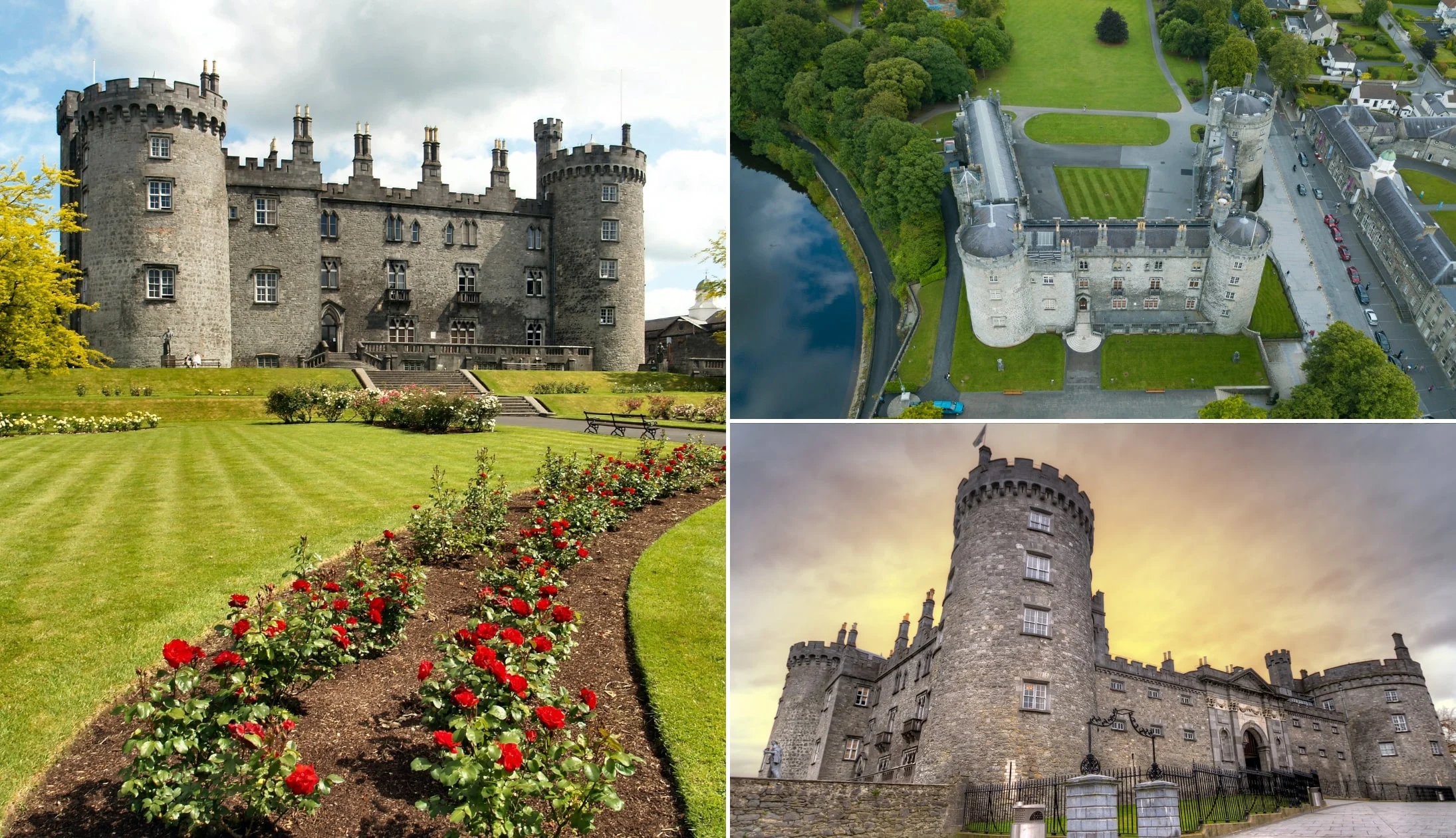Jerpoint Abbey truly is a sight to behold.
Among the best-preserved ruins of a Cistercian abbey in Ireland, some of the ancient structures at Jerpoint date back to the 12th-century.
It’s famous for its incredible carvings and statues, and the whole site is steeped in history.
You don’t have to be a history buff or particularly religious to be fascinated by this incredible site. Let’s find out more.
Some quick need-to-knows about Jerpoint Abbey

Photos via Shutterstock
Before you make a pilgrimage to this epic abbey, let’s cover the basics, first:
1. Location
Jerpoint Abbey is located about 2.5 km outside of the small riverside town of Thomastown in County Kilkenny. It’s about 20 km south of Kilkenny City, which is normally around a 20-minute drive. Close to the banks of the River Nore, it enjoys stunning scenery, in a landscape dotted with ancient ruins.
2. Admission
Jerpoint Abbey is a very affordable attraction. Tickets cost:
- Adult: €5.00
- Group/Senior: €4.00
- Child/Student: €3.00
- Family: €13.00
3. Opening hours
The opening hours for Jerpoint Abbey vary throughout the year. Here’s how they stand (note: times may change):
- 17 March – 31 March: 09:00 – 17:00
- 1 April – 30 September: 09:00 – 17:30
- October: 09:00 – 16:30
- 01 November – 11 November: 09:00 – 16:00
History of Jerpoint Abbey

Jerpoint Abbey is one of the oldest and best-preserved Cistercian abbeys in Ireland. It dates back to the second part of the 12th-century.
In 1180, monks of the Cistercian Order were moved to the current site of Jerpoint Abbey by order of the King Of Ossory.
The construction of Jerpoint
Here he constructed the abbey, though it’s likely that it was built on the site of a former Benedictine monastery, built in 1160.
Felix Ua Duib Sláin, or Felix O’Dullany, was the Bishop of Ossory between 1178 and 1180, and some people credit him with the founding of the abbey.
After his death in 1202, he was buried at Jerpoint Abbey, with his effigy depicting a snake biting his crozier, a stylized staff used by high-ranking bishops. It is claimed that many miracles have been performed at his tomb since his burial.
The Dissolution of the Monasteries
Jerpoint Abbey thrived for hundreds of years, right up until King Henry VIII’s Dissolution of the Monasteries act came into force around 1536.
Oliver Grace, the last abbot of Jerpoint Abbey, surrendered the abbey to the king, and in 1541 it was granted to James Butler, the 9th Earl of Ormond.
Enter the Butler family
After this, Jerpoint Abbey became a popular place for the Butler family, and other powerful families in the region, to inter their dead. However, as the years wore on, the abbey fell into partial ruin.
In 1880, it was declared a national monument and has been cared for by the Office of Public Works ever since.
Nowadays, it boasts an informative visitor centre, guided tours, and a fascinating series of exhibits for the public to enjoy.
Things to see, do and look out for at Jerpoint Abbey

Photos via Shutterstock
As you stroll the grounds and take in the sights, there are plenty of things to see and do. Here’s what to look out for.
1. The ruins
Parts of the main church structure date back to around 1180 to 1200 and amazingly it’s still relatively intact. The mighty stone walls have truly stood the test of time.
Thick columns continue to support the impressive arches and window holes, and you can still easily see the form of the entire building.
Amid the ruins, you can also find countless carvings that despite hundreds of years of weathering, still retain their visages. Other parts of the church are slightly newer, with the iconic tower dating back to the 15th-century.
2. The monk’s choir
As you stroll through the ruins, you’ll find yourself within various sections of the old church. The monk’s choir is separated from the rest of the nave by way of a mighty arcade.
The only remaining column from this impressive structure is also the most elaborately decorated. Look out for Romanesque motifs on the scrolling that adorns the sturdy column.
3. The nave
One of the best-preserved parts of Jerpoint Abbey, the western half of the nave stands tall to this day. Here is where sermons were given way back in the 12th-century, and the wall forms a peak where the roof would have laid.
Three large windows can easily be seen on the gable end, plus one smaller central one above them. The side of the nave boasts a series of arches, leading to the aisle.
4. The aisle
Separated from the nave by an arcade of pointed arches supported by square and circular columns, the north aisle of the former church is incredibly well-maintained.
Simple yet beautiful scalloped edges decorate the columns in a subtle but attractive fashion.
5. The tower
Originally serving as a belfry, the crossing tower at Jerpoint Abbey was a later addition to the church. It was built in the 15th-century, but a quick glance and you’d think it was only built a few years ago.
The tower stands almost entirely complete from top to bottom. Perfectly square, it’s well worth taking a look up at the ribbed vault ceiling, a marvel of medieval engineering.
Four large arches open up to the nave, the chancel, and the two transept arms. Within the tower, you’ll find a number of reassembled tombs, floor slabs, and burial slabs.
6. The cloister
The cloister is the large open, grassy quadrangle surrounded by stone archways and arcades. The west and south sides of the arcade have survived to this day, including some parts that were reconstructed by the Office for Public Works in the 1950s.
This still gives you an amazing insight as to how the whole site would have looked all those years ago. Examining the pillars and archways will reveal a number of highly carved columns and arches, depicting human, animal, and grotesque figures.
7. The engravings
Jerpoint Abbey is perhaps best-known for the sheer number of incredibly well-preserved engravings and carvings. Throughout the abbey, you will find an array of decorative touches that are typically uncommon among Cistercian abbeys.
A carving of St. Catherine stands out as one of the oldest surviving examples in Ireland, while numerous knights, abbots, and other figures stand proud, their features barely touched by the winds of time.
You’ll also find a host of unusual creatures carved into the pillars and stonework. On top of that, the abbey is filled with medieval tombs, epitaphs, and effigies.
8. The Visitor Centre and Kids treasure hunt
The visitor centre houses a small but fascinating exhibition of artifacts that have been discovered on the site over the years. It’s also the place to discover more about the history of Jerpoint Abbey.
For kids, it’s also where the treasure hunt starts. With a list of things to find among the ruins, such as specific tombstones, statues of 13th-century knights, and carvings of exotic creatures, it’s a great opportunity to learn while having fun.
Things to do nearby
One of the beauties of Jerpoint Abbey is that it’s a short spin away from many of the best places to visit in Kilkenny.
Below, you’ll find a handful of things to see and do a stone’s throw from Jerpoint.
1. Kells Priory (11-minute drive)

Photos via Shutterstock
Kells Priory is one of the largest of County Kilkenny’s medieval marvels. This Augustine priory features a number of iconic tower houses, making it look more like a fortress than a place of worship. The ruins remain largely intact, making this a magical place to stroll around. With guided and self-guided audio tours available, you can delve into the history and majesty of this major Irish monument.
2. Kilkenny City (20-minute drive)

Photos via Shutterstock
The city of Kilkenny, formally the medieval capital of Ireland, is a must-see if you’re in the area. The historic streets and buildings, housing a variety of pubs, restaurants, cafes, and craft shops, lend the city a magical vibe. There are plenty of medieval marvels and attractions along the medieval mile, including museums, and of course, Kilkenny Castle.
3. Walks

Photos via Shutterstock
County Kilkenny is a great place to stretch the legs, with an array of walking routes to indulge in. From Jerpoint Abbey, you’re conveniently located to take part in a number of excursions. Nearest to hand is the riverside ramble from Thomastown to the nearby village of Inistioge, and from there you can take a stroll to and through Woodstock Gardens. For a bit of hill climbing, both Brandon Hill and Tory Hill are less than 30-minutes away, with both offering fantastic trails and sights.
4. Gorgeous villages

Photos via Shutterstock
This part of County Kilkenny is also home to various beautiful villages. Inistioge is among the most well-known, with its quaint village green, hilly roads, and historic buildings. Plus, sitting on the banks of the River Nore, it enjoys stunning natural surroundings. Alternatively, Graiguenamanagh sits on the banks of the River Barrow and is another excellent place to drop by for lunch or fun on the river. And from there, St. Mullins is another postcard-perfect village that’s steeped in history.

